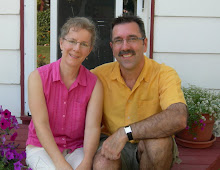On the map below, Cape Horn is at the bottom of the screen on the red line.

In the past, I had assumed that the name came from the shape of the lower end of the continent . . . sort of like a horn . . . at least in my head!

It turns out that the island was named by some Dutch explorers in 1615. They called it Kaap Hoorn after their home town, "Hoorn" in the Netherlands. (Hoorn was also the name of a ship on their expedition that burned while in Patagonia) The English later changed the name to Cape Horn, and the Spanish refer to it as Cabo de Hornos.
The rock formations on the right of this shot are called the "Two Cathedrals".


The Two Cathedrals can be seen in the distance in this clip as I pan over to Cape Horn.
And there she is . . . Cape Horn, the sailor's graveyard!!

Seeing the island was, of course, a scenic pleasure . . . but more than that, it was a psychological moment of wonderment! I believe that most travelers and students of history / geography would consider "Rounding the Cape" to be a "Must Do Someday". . . . and there we were!

In the British Navy, any sailor who successfully completes the journey is given the title of "Mossback" (we don't know why they chose this name).
This area has such a reputation for having rough seas that I was looking forward to 20 foot waves. Sadly, I was disappointed at how smooth our passing was . . . but that's just me! Others were just fine with the smooth sailing.

Cape Horn is the northern most point of the Drake passage, and that meant, at 56 degrees south of the equator, we were about 600 miles away from Antarctica. At one time this was an important trade route, but, at the same time, it was a notoriously dangerous stretch of ocean due to high winds, large waves, icebergs, and rocky coastlines. Even today, navigating the horn is considered to be a major yachting challenge.
Speaking of dangerous rocks, we approached these just to the east of the cape.




In this video, the above rock formations come into view from the right while at the end of the video, Cape Horn is starting to fade into the distance . . . and into our memories.
This is Chilean territory, and if you look closely, you will see a naval outpost. There is also a monument to past mariners who have lost their lives attempting to round the horn. The monument is a silhouette of an Albatross. The legendary birds are often regarded as the souls of lost sailors.

So . . . we did it! Unlike many poor souls before us, we rounded Cape Horn and lived to tell the story. That meant that we would soon be in the open waters of the Atlantic as we headed toward our next port of call, the city of Stanley in the Falkland Islands. Unless we stumble on a left over land mine, we'll be playing with penguins in no time! (It should take us a little less than 24 hours to get to the Falklands.)

Just before we go, here's a tidbit for any ornithologists out there. On the way to the Falklands, we noticed some large birds following the ship. We appeared to be several miles from shore which made their appearance even more surprising. We later found out that they were Giant Petrels. They are similar to an Albatross in size (6 - 7 ft wingspan) and shape but are brown instead of white.
Hasta luego,
Norm y Charlene

No comments:
Post a Comment